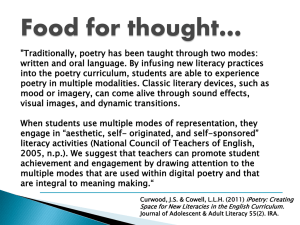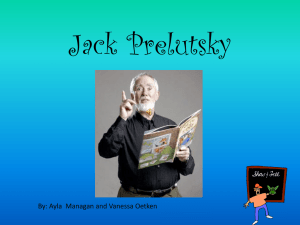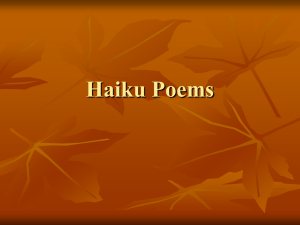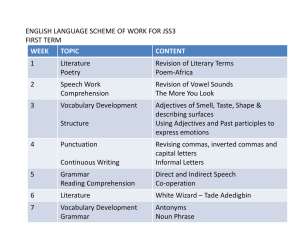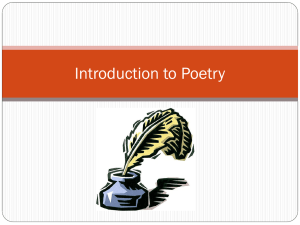Lesson Plan Four
advertisement
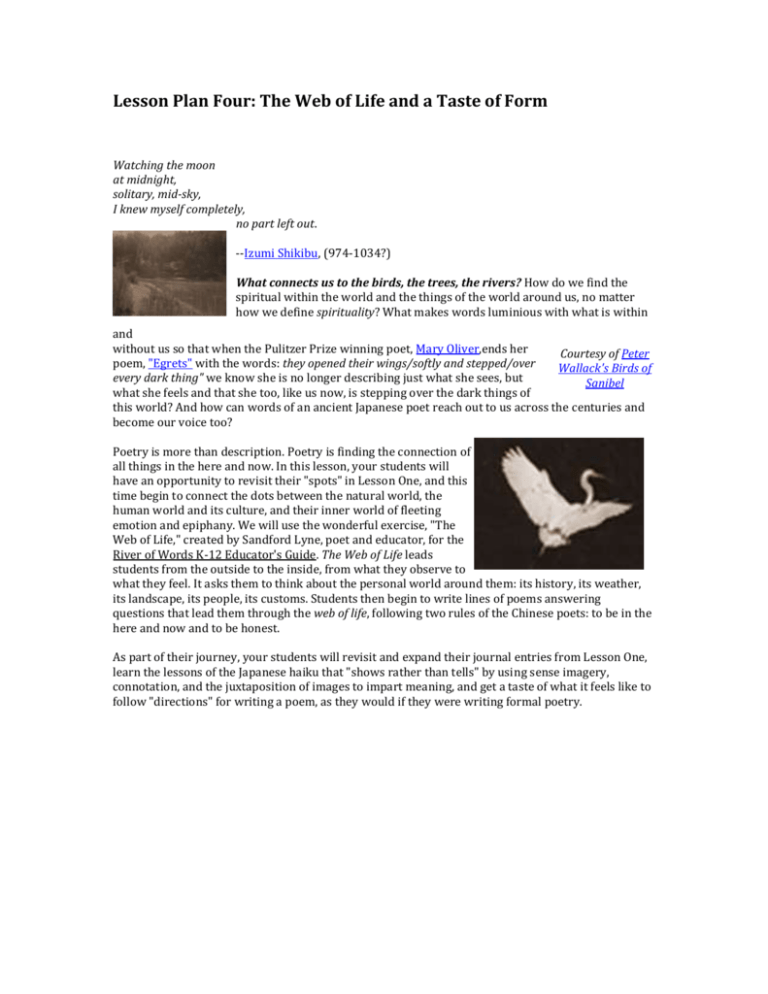
Lesson Plan Four: The Web of Life and a Taste of Form Watching the moon at midnight, solitary, mid-sky, I knew myself completely, no part left out. --Izumi Shikibu, (974-1034?) What connects us to the birds, the trees, the rivers? How do we find the spiritual within the world and the things of the world around us, no matter how we define spirituality? What makes words luminious with what is within and without us so that when the Pulitzer Prize winning poet, Mary Oliver,ends her Courtesy of Peter poem, "Egrets" with the words: they opened their wings/softly and stepped/over Wallack's Birds of every dark thing" we know she is no longer describing just what she sees, but Sanibel what she feels and that she too, like us now, is stepping over the dark things of this world? And how can words of an ancient Japanese poet reach out to us across the centuries and become our voice too? Poetry is more than description. Poetry is finding the connection of all things in the here and now. In this lesson, your students will have an opportunity to revisit their "spots" in Lesson One, and this time begin to connect the dots between the natural world, the human world and its culture, and their inner world of fleeting emotion and epiphany. We will use the wonderful exercise, "The Web of Life," created by Sandford Lyne, poet and educator, for the River of Words K-12 Educator's Guide. The Web of Life leads students from the outside to the inside, from what they observe to what they feel. It asks them to think about the personal world around them: its history, its weather, its landscape, its people, its customs. Students then begin to write lines of poems answering questions that lead them through the web of life, following two rules of the Chinese poets: to be in the here and now and to be honest. As part of their journey, your students will revisit and expand their journal entries from Lesson One, learn the lessons of the Japanese haiku that "shows rather than tells" by using sense imagery, connotation, and the juxtaposition of images to impart meaning, and get a taste of what it feels like to follow "directions" for writing a poem, as they would if they were writing formal poetry. Lesson Four Pre-Poem Assignment: The Culture of Place Stone Dwelling at Mesa Verde In Lesson One, your students chose a place near water to write about. They were asked to describe in their journals the physical characteristics of the area, the water characteristics, weather, flower and plant population, and bird population. For this poem, your students will begin by expanding upon their earlier observations of their water spots by exploring what they can of the culture and history of the place and the area around it, as well as their own family history and culture. They can ask family members for information, explore guide and tourist books, history books and encyclopedias to gather information about their place. Who might have visited this place before? Or lived there? What kind of dwellings exist on their spot now, or might have existed there a long time ago? Encourage them to find and use the proper names of things, such as the names of the people, the foods, dwellings, and objects they might find and record their findings in their journals. Pre-Poem Resources and Assignment Instructions Writing the Journal: You might want to refer back to Unit One and the example of the Powell journal entry if it's been awhile since your students have worked on their journals. This journal exercise is quick, serving as a way to get your students to think about the human history of their water spot and the area surrounding it. It's also a chance to get your students thinking about their own family history and culture before they begin following the Stanford Lyne Web of Life Poetry exercise. Questions to Consider for Journal entries 1. What is the human history of your place: who lived there before you? Who lives there now? Who else might have come to this place, past or present? 2. Are there any archeological sites? Dwellings? Has any one found any man made objects there, old and new? 3.What were the spiritual beliefs of those who lived near this area? Do any spiritual places exist in the area? What is your family’s spiritual history? 4. Are there any foods for which the area or region is known? 5. What languages were/are spoken in the area? 6. What types of people live in the area? 7. What is your area famous for? Once students have completed their journal entries, ask them to share their discoveries with each other in groups. Ask first for a volunteer to share his or her journal with the whole class. Lesson Four The Poem Assignment: The Web of Life Poem At this point, your students should have had a chance to write their journal entries on the cultural history of their place and to review and expand upon their earlier Lesson One journal entries describing the characteristics of the place. In preparation for writing their poems, your students will first begin a new journal entry, using the Poetry: Life is the Teacher: Writing Poems from Daily Experience. lesson as guidance for refining their earlier observations. Once they have brainstormed what will become lines of poetry for their Web of Life poems, they will begin to assemble their poems following the structure of the Web of Life. Mu Tamagawa: Six Jewel Rivers Sleep on horseback, The far moon in a continuing dream, Steam of roasting tea. Basho 1644-1694 To prepare for this part of the exercise, familiarize yourself with the Poetry: Life is the Teacher: Writing Poems from Daily Experience. handout below by Sandford Lyne. The Web of Life poem is an exercise in poetry writing that leads students from the outside to the inside, from what they observe to what they feel. It asks them to think about the personal world around them: its history, its weather, its landscape, its people, its customs. Using what they have already gathered in their journals, students will begin to write lines of poems in answer to questions that lead them through the web of life. The Web of Life Poem asks students to follow two rules of the Chinese poet: to be in the here and now and to be honest. In following the web of life directions, your students learn how to show their feelings in poetry, rather than tell them.Certainly for the beginning poet, "showing not telling" can be a challenge. Before students begin answering the questions in the Poetry: Life is the Teacher: Writing Poems from Daily Experience., you may want to introduce them to another type of poem that too uses imagery, connotation, and the juxtaposition of images (often the pairing of unlike images) to impart meaning--the Japanese Haiku. The Poem Resources and Assignment Instructions Creating the Web of Life Poem: To begin the Web of Life poem, share the poetry concepts in the Sanford Lyne handout: Poetry: Life is the Teacher: Writing Poems from Daily Experience. To help your students understand the Chinese concept of being in the here and now, and the idea of "showing, not telling" in a poem, share the poetry form, haiku, with them. Focus on how these poems are in the present tense and work with sensory imagery to impart meaning--often emotional meaning rather than logical meaning. You might have your students practice writing a few haiku. Once everyone has grasped these concepts, lead your students through the Web of Life with a series of questions that will prompt them to create lines of poetry out of their journal observations. Click on the links* below for: Poetry: Life is the Teacher: Writing Poems from Daily Experience by Sandford Lyne in the River of Words K-12 Curriculum, pp 132-138. This poetry lesson presents a specific way of looking at and writing poetry and offers a detailed plan for guiding your students into the Web of Life poem. Permission has been granted by River of Words for use of this document here. Regarding Poetry: The Shape of the Song by Peggy Willis Lyles. Accessed from World Haiku Review April 6 2004 This essay discusses the genesis of meaning in haiku, the essence of Japanese poetry. Learn how sense imagery, connotation, and the juxtaposition of images imparts unsaid meaning, what your students want to emulate in their web of life poems. Children's Haiku Garden This website offers a variety of haiku poems written by children across the world. Each haiku is accompanied by an illustration. Science Extension Activity: An Eye for Detail In Lesson One, students recorded their observations in writing. This time around, students will continue to practice their observational skills through attempts to visually recreate what they witnessed. As they draw what they see and capture it through their own artistic creations, their attention to detail will increase. Whether or not you can return to the site of the original observations, you can have your students draw what they recorded earlier in their journals. Providing them with watercolors, crayons, markers, pencils, or other materials, encourage the students to either revisit their journals and draw what they wrote down or observe some part of their nature spot in close detail. Encourage the students to capture the size, color, shape and other characteristics of the wetland grasses, riverbank, lake or fish that they are trying to depict. Ask for volunteers to share and explain their creations with the class. Possible discussion questions: students think back to your discussion about Powell ‘s journals. Why was he so detailed oriented?) their poems? LESSON FIVE POEM SAMPLE After the Rain is in the spirit of the Web of Life poem After the Rain Gentle hands sway the trees and Ruffle the grasses beneath them. The storm cloud’s last tears hit the street. Painting it glossy black. Earth’s breath whisks the last of the gray from the sky To expose pale sun. The trees are a new green, Straight from the painter’s palette. Birds chorus from every bough, Celebrating the sun’s renewal. We walk, leash to hand, Six feet treading a joyous path through the puddles. Ingrid Hoff Eight Grade, Teacher: Sharon Summers Place Middle School Denver, Colorado Third Place, 2004 Colorado River of Words Poetry Contest For the Young Best here is for the very young to stick with the haiku form. The trick will be to help your students describe their spot with concrete language and to discover a surprise about their spot or how they feel about their spot. Recommended Resources Haiku Writing Worksheet Website by Word Dance Word Dance is an online Quarterly creative writing and art journal for kids K-8. It's Haiku worksheet clearly explains the concepts of the haiku and offers examples from K-8 kids. Children's Haiku Garden This website offers a variety of haiku poems written by children across the world. Each haiku is accompanied by an illustration.



